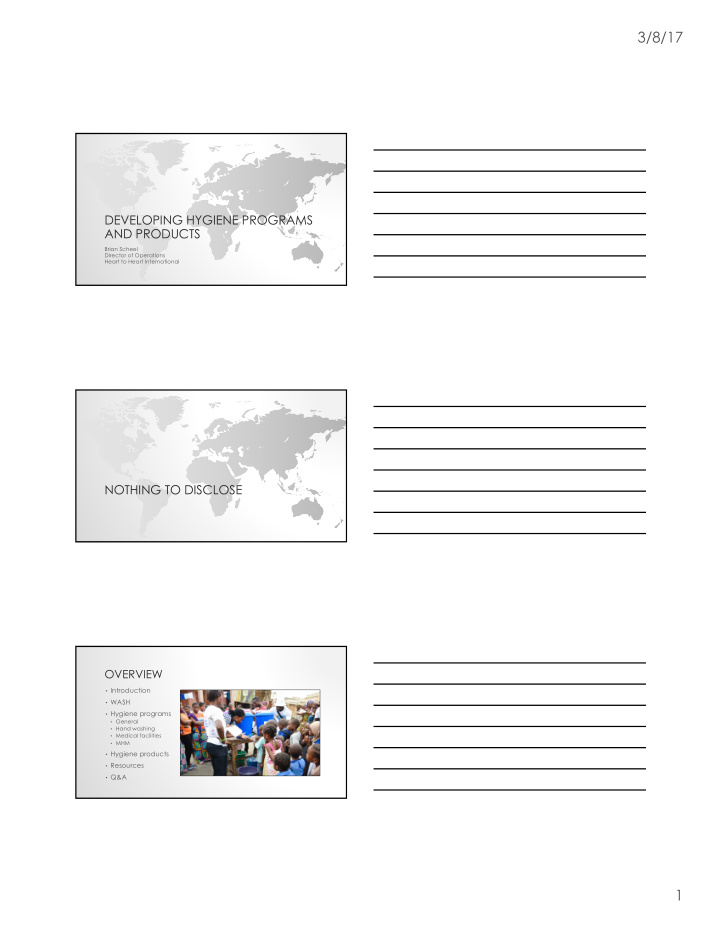



3/8/17 DEVELOPING HYGIENE PROGRAMS AND PRODUCTS Brian Scheel Director of Operations Heart to Heart International NOTHING TO DISCLOSE OVERVIEW • Introduction • WASH • Hygiene programs • General • Hand washing • Medical facilities • MHM • Hygiene products • Resources • Q&A 1
3/8/17 INTRODUCTION • Water, Sanitation and Hygiene (WASH) • Separate programmatic fields • Each is dependent on the other • Without sanitation, water sources are contaminated • Without clean water, basic hygiene practices are not possible • Without basic hygiene practices, clean water and sanitation are less effective • Hygiene • Hygiene promotion • Identification and use of hygiene products INTRODUCTION • Impact of WASH • Health • Shelter • Nutrition • Education • Integrated approach • Understand organization capacity • Conduct needs assessment • Share information • Coordinate • Coordinate • Coordinate IMPORTANCE OF WASH • WASH is critical regardless of programmatic context • Disaster response • Development • Especially critical in the initial stages of a disaster • Disaster-affected people are more susceptible to disease • Inadequate sanitation • Inadequate water supply • Inability to maintain good hygiene • Diarrheal diseases transmitted by fecal-oral route 2
3/8/17 OBJECTIVE OF WASH • Objective is the same regardless of programmatic context • Disaster response • Development • Reduce the transmission of fecal-oral diseases and exposure to disease bearing vectors through: • Good hygiene practices • The provision of safe water • The reduction of environmental health risks • The conditions that allow people to live with good health, comfort and security • Protect health OBJECTIVE OF WASH • Simply providing water, sanitation facilities and hygiene products is not sufficient • People must be given information • People must be able to take ownership • Knowledge • Programmatic activities • Better disaster response through better preparedness • Relationship building • Contingency planning • Stockpiling equipment and supplies • Emergency services and stand-by arrangements • Personnel/community-level training and drills ROLE OF HYGIENE IN WASH • Hygiene is integral to all aspects of WASH • Water supply • Excreta disposal • Solid waste management • Vector control • Drainage • First and last line of defense • Prevent water, sanitation and hygiene-related diseases • Protect health 3
3/8/17 HYGIENE AND ITS CHALLENGES • What is hygiene? • The practice of keeping oneself clean • The practice of keeping one’s environment clean • Reducing the risk of infection for oneself and one’s community • What are some challenges in designing hygiene programs? • Understanding the need • Identifying solutions that are both: • Feasible • Culturally appropriate • Educating • Individual • Community DEVELOPING HYGIENE PROGRAMS • Needs assessment and analysis Coordinate • Multi-sector • Harmonized approach • Optimize community participation • • Women • Children • Older people • Persons with disabilities The less visible • Inclusion is critical • Identify hygiene problems • Culturally appropriate solutions • • Strategic planning Priorities • Potential gaps • Accountabilities • Funding requirements • 4
3/8/17 DEVELOPING HYGIENE PROGRAMS • Resource mobilization • Staff • Products • Money • Implementation • Optimize participation • Public education • Feedback process • Community ownership • Exit strategy • M&E HAND WASHING • What is the most effective and cost-effective hygiene practice in developing countries? • Handwashing • Soap and water • Hands come into contact with feces, nasal excretions and other bodily fluids • Hands are vectors • Viruses • Bacteria • Parasites 5
3/8/17 HAND WASHING • Handwashing is especially important • Where people congregate • Offices • Schools • Places of worship • Where ill or vulnerable people are concentrated • Hospitals • Nursing homes • Where food is prepared/shared HYGIENE IN MEDICAL FACILITIES • Thousands of people die every day from infections acquired while receiving health care • Anyone involved in direct or indirect patient care needs to practice good hand hygiene • Alcohol-based solution • Soap and water • Protect patients, protect health care workers, protect health 6
3/8/17 MENSTRUAL HYGIENE MANAGEMENT • Taboo in many environments • Girls and women need MHM products • Girls need supportive environment at home and school Parents • Teachers • Female • Supportive • WASH facilities • • Safe Private • Adequate • Quantity • Cleanliness • Gender segregated • Discrete disposal of MHM products • • Adjacent/nearby water source 7
3/8/17 HYGIENE PRODUCTS • Basic hygiene products • Additional hygiene products • Water containers • Comb • Laundry soap • Shampoo • Bathing soap • Toothbrush • MHM items • Toothpaste • Nail clippers • Disposable razor • Underwear for girls and women • Lotion for infants and children up to two years of age • Nappies/diapers HYGIENE KITS 8
3/8/17 RESOURCES • The Sphere Project: Humanitarian Charter and Minimum Standards in Humanitarian Response • AID: All In Diary, Essential Guide to Humanitarian Good Practice • Global Hand Washing Partnership • UNICEF 9
Recommend
More recommend